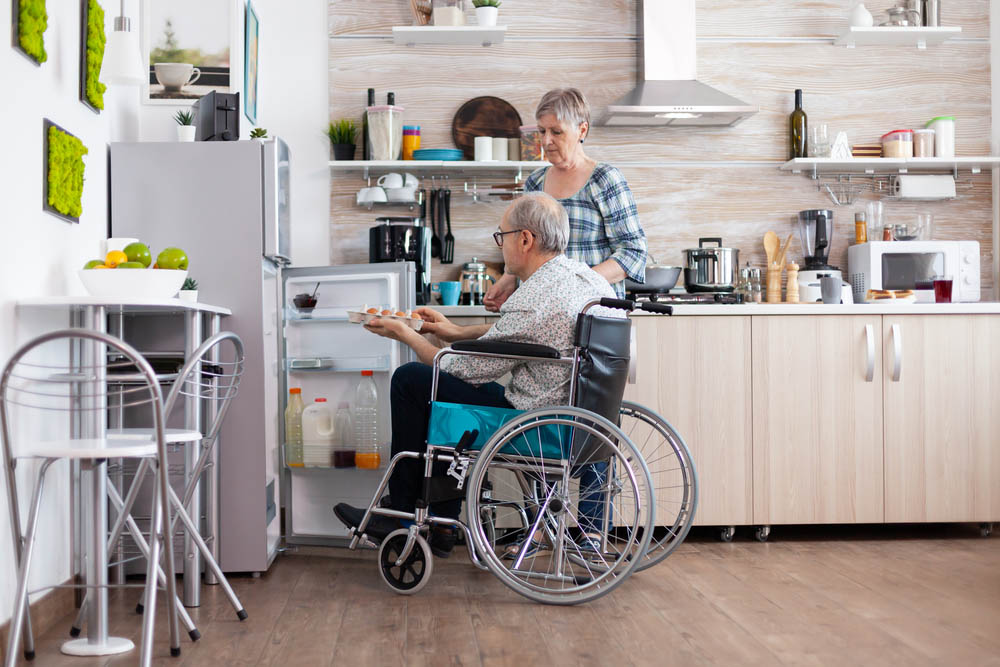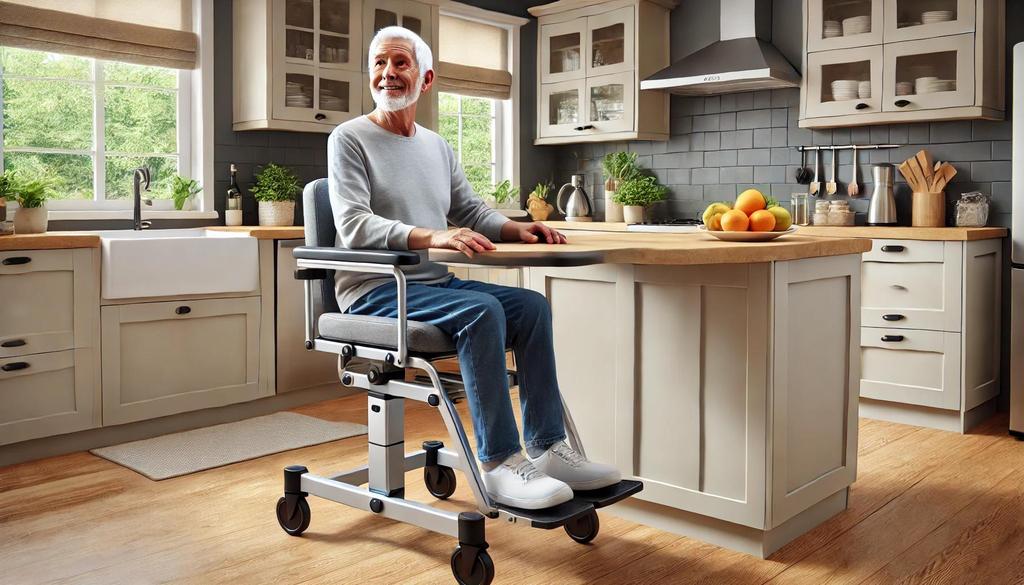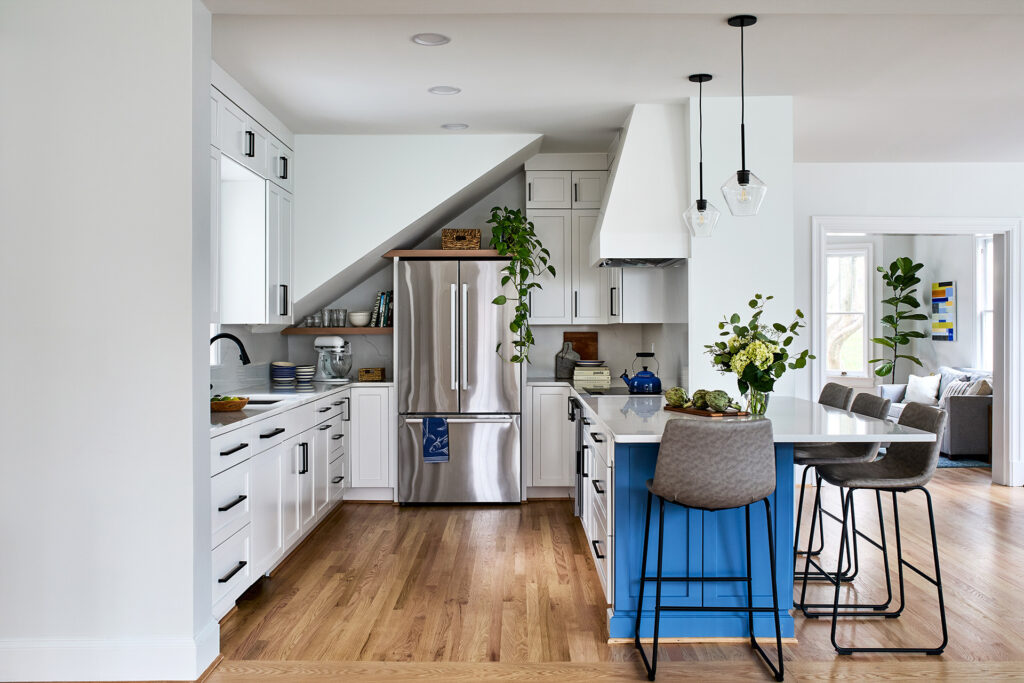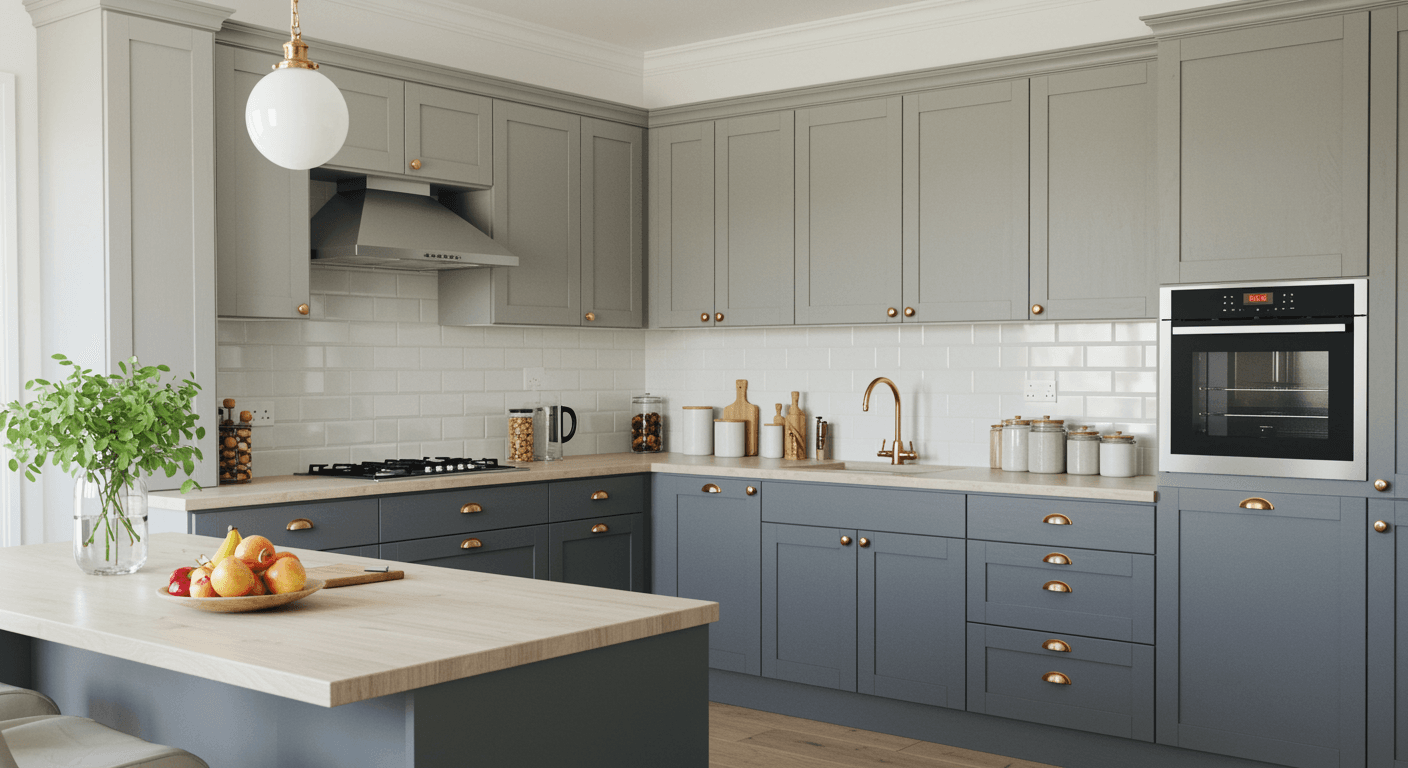Senior friendly kitchen focuses on safety, accessibility, and simplicity of usage. Reduce risks by including rounded countertop edges, lever-style handles, and non-slip flooring. Arrangements for comfort and convenience of appliances, storage, and lighting help elderly people become independent.
Senior Friendly Kitchen 1: Layout and Flow
A well-planned flow and design that guarantees senior comfort, convenience, and safety underlies a senior-friendly kitchen. Particularly for those using walkers or wheelchairs, a light and big kitchen design eliminates roadblocks and makes for simple movement especially as age may result in mobility and equilibrium deterioration.
Countertops and kitchen islands should be at least 1.2 to 1.5 meters apart to ensure sufficient space. Though it reduces the energy and distance needed for daily chores like cooking and cleaning, the traditional work triangle idea—positioning the refrigerator, burner, and sink close together still resonates. Level floors and smooth, non-slip flooring help to create more stable and safe walking.
Maintaining often used devices and storage within easy reach also avoids excessive stretching or bending. Including a retracted workplace or smaller counter would make the kitchen more approachable and welcoming for seniors who like seated food preparation. Good lighting therefore helps to clearly define roads and job sites, hence promoting effective movement. Avoiding acute angles and including large, clear entrances ensures safer navigation and lowers accident risk.
Essentially, the aim is to design a kitchen layout intuitive and readily accessible where all objects are close by and movement looks natural. Ergonomics and flow in a senior-friendly kitchen inspire daily living confidence and independence in addition to increasing usefulness.
Senior Friendly Kitchen 2: Safe Countertops and Flooring

Choosing safe flooring and counters helps to prevent mishaps and promote ease when planning a senior-friendly kitchen. Counters with rounded or bullnose edges will reduce the chance of injury from unexpected falls or knocks.
Matte or low-gloss finishes reduce the glare that could be annoying for elderly eyes. Materials like quartz or solid surface countertops guarantee a flawless workplace by providing a smooth, easy-to-clean surface that fights staining and germs. Because it enhances visibility and enables seniors to swiftly identify working areas, maintaining a clear colour tone between cabinets or flooring and countertops is also very important.
@ampquartzcabinets Cantikkan laundry area + open shelving macamni? 😍 Idea pinterest ni tau! #AmpQuartz #LaundryArea #OpenShelves #PinterestKitchen
♬ original sound – AmpQuartz – AmpQuartz
Among the components of flooring, traction and stability should rank first. Any slick surface — polished marble or tiles can present a significant fall risk. Consider textured ceramic tiles, rubber, or non-slip vinyl for durability and safety. Furthermore, these products have a small cushioning effect that helps to reduce exhaustion when standing for a long duration. Mats or rugs ought to be low-profile and kept from tripping using non-slip backing. Stopping sharp edges that could hook on walkers, wheelchairs, or shoes is just as important across different grades among several flooring materials.
Since seniors could have trouble with rapid cleaning, flooring should be spill proof and easy to upkeep as well. Homeowners may create a kitchen environment that boosts older people's independence, safety, and self-confidence without giving up grace.
Senior Friendly Kitchen 3: Design with Dignity
Creating a senior-friendly kitchen goes beyond safety; it's about making a room that upholds dignity, autonomy, and comfort. Designed with dignity, a kitchen helps seniors to cook, eat, and socialise with confidence by blending utility with warmth. It begins with selecting characteristics that enable simple operation without looking clinical.
Ergonomic handles, pull-out drawers, and touch less faucets, for instance, provide accessibility while still keeping a contemporary, sophisticated appearance. While non-slip flooring and curved counter edges subtly boost safety, warm, neutral colour schemes coupled with soft lighting generate a calming ambiance. Multi-level countertops or accommodating different levels of mobility, seated preparation rooms let seniors work easily whether seated or standing.
Smart home technology such motion-sensor lighting or voice-controlled Beyond practicality, careful placement of storage, appliances, and often used items at accessible heights lowers strain and supports daily independence. Appliances add convenience and promote self-reliance. Personal touches such as showing treasured kitchenware or family pictures foster familiarity and emotional well-being.
A respectable design harmonises rather than removes character for usefulness. A space that is inviting and inspiring may be created by means of safety and aesthetics. A dignified elderly-friendly kitchen eventually lets elderly people keep up with regular activities and social interactions, therefore bolstering pride, independence, and belonging in the core of the house.
Senior Friendly Kitchen 4: Comfortable Work Zones

Designing a senior-friendly kitchen that fosters both safety and independence depends on creating pleasant work areas. Thoughtful design modifications can simplify and enhance daily activities since mobility and physical strength might decline with age.
One simple solution is to include multi-level counters so that customers can pick a working height — standing or seated that suits them best. Seniors using wheelchairs or those who prefer to sit when cooking would benefit most from lower counter or pull-under workstations. These spaces provide lots of legroom and help to relieve shoulder and back pressure.
@ampquartzcabinets Terima kasih kerana memilih AmpQuartz! Orang Johor yang nak buat macamni boleh PM kami sekarang! 🤩🥳 #AmpQuartz #SolidPlywood #EuropeanDesign #KitchenCabinet #fyp
♬ Vlog ・ Stylish city pop(1275391) – orino
Ergonomic design also guarantees that regularly utilised objects including utensils, cookware, and little appliances are kept between waist and shoulder height, therefore lowering the demand for bending. or attaining. Furthermore providing more working space when needed without cluttering the kitchen are pull-out cutting boards and slide-out work surfaces. Good visibility from strong task lighting over these areas lowers accident risk. To reduce tiredness during longer cooking sessions, pleasant workspaces should also incorporate sympathetic flooring such as cushioned vinyl or cork.
The aim is to provide senior citizens a setting where they can move freely, prepare meals securely, and retain their confidence in the kitchen. Designed with keeping accessibility and comfort in mind, these practical workstations turn the kitchen into a motivating environment that suits the needs of the user, making sure cooking is still a pleasure instead of a burden.
Senior Friendly Kitchen 5: Appliance Accessibility
The degree of appliance accessibility determines in large part the design of a senior-friendly kitchen that gives safety, comfort, and usability first attention. Choosing and arranging culinary equipment thoughtfully may help everyday chores be more doable while lowering the risk of strain or accidents as mobility and dexterity may diminish with age.
Wall ovens installed at waist height eliminate the requirement to reach or stoop into low cabinets; side-opening doors provide safer access to hot meals. After usage, they cool fast and reduce burn danger; induction cooktops also provide a fantastic choice. Choosing refrigerators with French doors or pull-out drawers also enables elderly people to readily reach fresh meals without too much flexing. Dishwashers elevated somewhat above ground might also aid in preventing unneeded back pain and bending.
For those with arthritic problems or poor hand strength, substituting lever handles or touch controls on ovens, microwaves, and faucets for typical twist knobs increases user-friendliness. Arranging equipment close to important work spaces, for example, a microwave near a counter — helps to simplify the workflow and reduce movement.
Little additions such contrasting control labels, appropriate illumination, and crisp digital displays greatly boost visibility and confidence during use. These smart appliance choices together, placements foster autonomy and pleasure in cooking, hence assisting elderly people to retain their independence and supporting the building of a safer atmosphere, their connection to one of the most calming daily practices.





